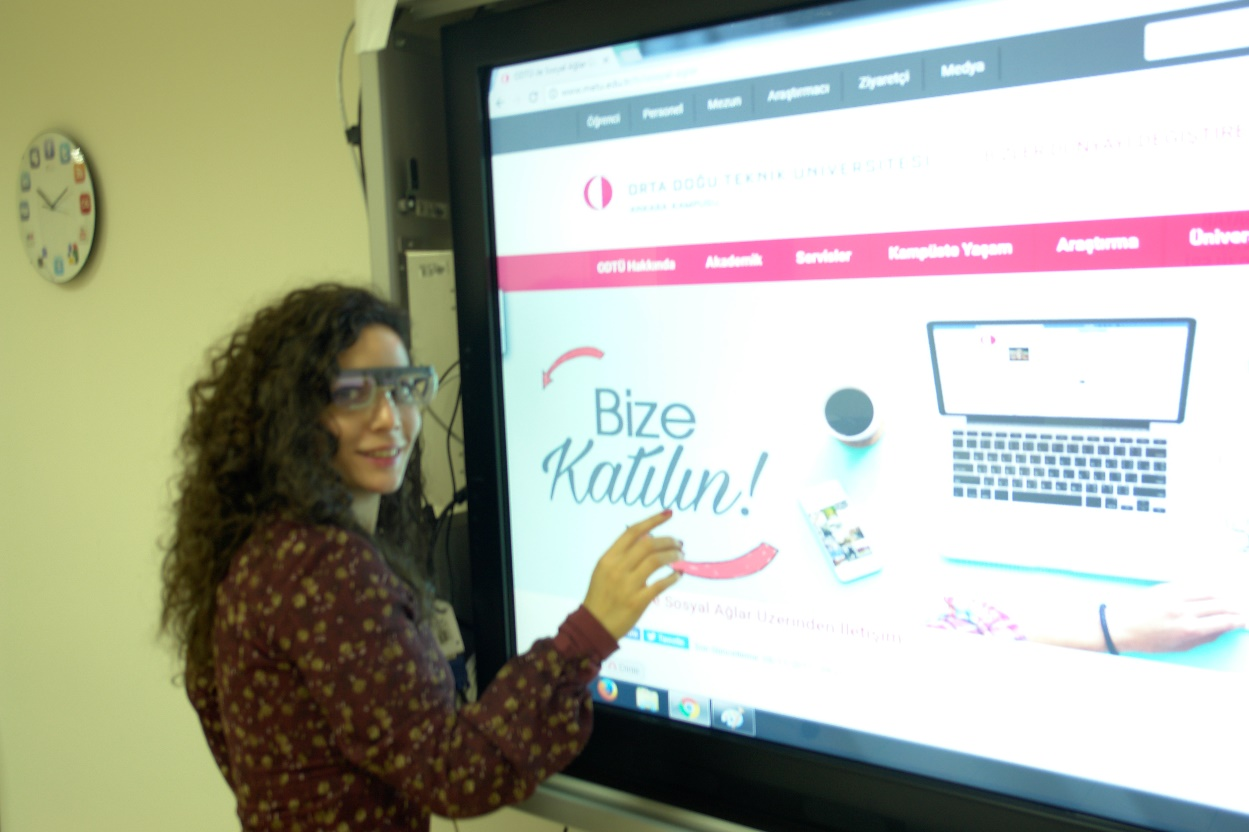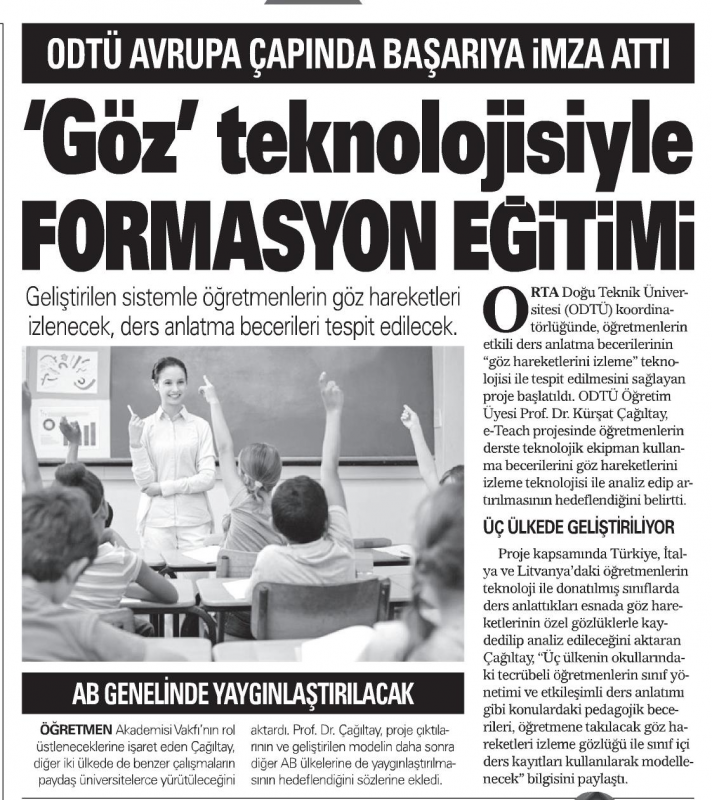
Topic(s) addressed
The e-Teach project aimed to discover teaching techniques and methods in educational technology equipped classrooms (ETECs) in order to meet the training requirements of teachers. During lessons, eye-movement data belonging to expert and novice teachers from 3 different countries were collected through the use of eye-tracking glasses, with comparisons made among teachers’ eye movements in order to reveal expertise in ETE teaching. Teaching methods and techniques used by expert and novice teachers from all 3 countries were compared, and suggestions proposed. The different teaching techniques that are used across various European geographical regions were also analysed and reported, with these outputs used in the design and development of e-learning content for teachers towards improving in-class technology interaction practices. The project’s outputs, “on-line course contents,” are hosted on METU’s Bilgeİs MOOC platform, which is co-funded by the European Union and the Republic of Turkey.
Target groups
The project’s target groups were middle schools (corresponding to primary education in Turkey), teachers, academicians, teacher education departments, and Ministries of Education; in short – those who acquired teaching knowledge from ETE. The project was carried out in 3 countries (Turkey, Italy, and Lithuania) with academicians and teachers from 3 middle schools. The project’s number of participants was 340 primary and secondary school teachers from the 3 participating schools. The project’s outcomes are applicable to teachers from all across Europe, which would mean that the overall number of reachable teachers were approximately 1,875,000 from all across the 3 participating countries.
Methodologies
Teachers from the fields of Social Sciences, Mathematics, and the Sciences jointly collaborated throughout the project. Given that teaching skills show common interdisciplinary characteristics, the project’s findings aimed to help teachers from all fields implement effective teaching practices. Good teaching requires content organisation, teacher-student interaction, engaging learning activities, classroom management, and learning assessments, with teachers’ key competences in the aforementioned areas directly recorded from their eye movements; following teaching sessions, teachers were then requested to watch their performance in class. Teachers self-evaluated where and how much they looked around the classroom (at students, materials, and blackboard), which students they had interacted with, which students they did not look at, and how teachers themselves performed. This method was particularly innovative given that eye-tracking technology was used to record and compare the eye movements of expert and novice teachers in order to define expert techniques and methods in the use of technological equipment in classrooms. Across all 3 partner schools, similar and differing teaching techniques were used during these observations, and teaching methods and techniques used by experts from various countries were compared and reported in order to produce e-learning materials. The e-Teach project explored teaching methods in ETEC teaching, which, prior to the study, had yet to utilise eye-tracking technology. Based on data collected from Turkey, Italy, and Lithuania, findings reflected common problems and solutions, with studies showing that the usage of ETE is on the rise globally. As was expected, there were various solutions from each partner institution that were grounded on cultural differences; however, the suggestions of this project remain transferable to any classroom with similar equipment and/or issues.
Environments
The different ETE teaching techniques used across different European geographical regions were studied using innovative eye-tracking technology, with the findings regularly shared with middle schools and their teachers, which helped them improve their respective teaching strategies. Teachers used a variety of resources in the classroom (both conventional and digital), and during the e-Teach project, several digital learning materials were developed so thousands of teachers could use them to improve their teaching skills. Said digital materials also trained teachers in good teaching and the utilisation of Web 2.0 tools in their lessons. As many courses as possible were included in the project’s study, consisting of Math, Science, and Turkish (Turkey); Italian, Math, and Science (Italy); and, Lithuanian, Russian and English (Lithuania). In this manner, teaching strategies were explored across several different disciplines, with analyses carried out on the ways in which different teachers utilise ETE classrooms. The e-Teach e-learning material greatly impacted the dissemination of the project’s findings, with the use of the digital course material substantially improving teachers’ teaching experience in ETE classrooms.
Teachers
Although the total number of teachers from participating schools numbered 340, not all of them had participated in the study. Participating teachers were grouped into groups of experienced (more than 5 years) and less experienced (less than 5 years) teachers, with their teaching processes recorded and analysed using eye-tracking technology. As previously stated, both experienced and novice teachers improved their teaching skills based on the outcomes of the e-Teach project; experienced teachers were able to fine-tune their existing teaching skills, while novice teachers had the chance to observe the teaching practices of expert teachers through their eyes, which helps them reach expert teacher level in a short period of time. In addition to this, the use of e-learning materials via Bilgeİş platform, helped teachers learn the use of Web 2.0 tools and the ways to integrate them into their lessons – thus helping them gain digital teaching competencies.
Impact
One of the project’s most innovative aspects was the use of eye-tracking technology to explore teaching processes, whereby teachers’ eye movements were recorded while they taught in ETE classrooms. The “teacher training e-course material” was one of the project’s most important outcomes, as it allowed teachers to become more knowledgeable in technological tools/software that may be used in education. Moreover, it also trained teachers on how to interpret the results of eye-tracking classroom analyses. This e-learning module is hosted on Turkey’s largest MOOC system, Bilgeiş. To date, the e-learning material has been accessed by a total of 3003 individuals, of which 1007 had successfully completed it and were awarded a certificate of completion. A sample certificate can be found at this link: http://e-teach.ceit.metu.edu.tr/project.html. One of the project’s main impacts was its ability to meet the gap in teachers’ knowledge on technology integration, resulting in enhanced classroom management by teachers and the use of technology during their lessons. One of the project’s major beneficiaries were children who had been educated in technology-enabled classrooms. European teachers, who became knowledgeable in the integration and use of technology in classrooms, were also able to better-educate their students across a number of countries. Partner institutions benefitted by learning how to extract knowledge from expert teachers through the use of eye-tracking technology. Eye-tracking glasses visually record teachers’ eye movements and reveals where and for how long teachers looked while teaching in a classroom, allowing the project to help educate novice teachers in the integration of technology into their lessons, the use of eye-tracking technology in education, and learning how to integrate innovative technologies into research based on their understanding of classroom dynamics. The result is better education quality that introduces effective teaching methods across local, regional, national, European, and international levels. The integration of new equipment into the classroom environment was facilitated through the use of e-learning materials, with various inputs provided to teachers during teacher-training programmes. The use of educational technology equipment within the classroom environment may prove to be highly beneficial to student success; in this sense, teachers play a critical role not only as primary users of the ETE equipment, but also as student guides and facilitators within the classroom. With proper application of this project’s activities, resulting outputs can be highly beneficial for teacher-training needs, which enables teachers to utilise technology in their classrooms, and ensures that students benefit from effective and efficient approaches to education.
- Reference
- 2017-1-TR01-KA201-046748
- Project locations
- Türkiye
- Project category
- Primary education
- Project year
- 2021
Stakeholders
Participants
Cenk Yakın Ortaokulu
- Address
- Türkiye
DamaSistem Ltd.
- Address
- Türkiye
Druskininkų "Saulės" pagrindinė mokykla
- Address
- Lithuania
Istituto Comprensivo Gragnano 3 Staglie Parco Imperiale
- Address
- Italy
Ministry of National Education
- Address
- Türkiye
Öğretmen Akademisi Vakfı
- Address
- Türkiye
Università degli Studi di Salerno
- Address
- Italy
Vilniaus universitetas
- Address
- Lithuania

